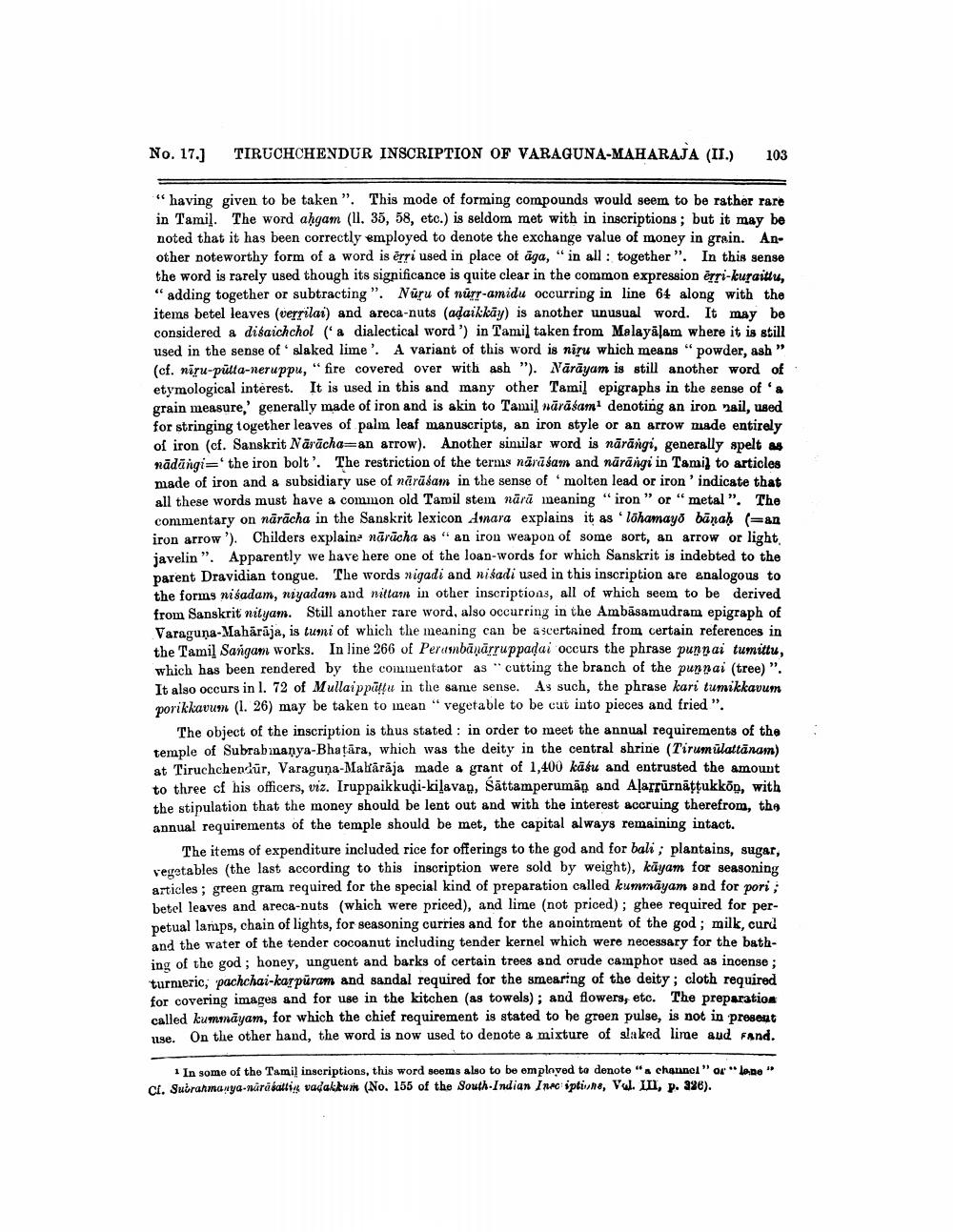________________
No. 17.]
TIRUCHCHENDUR INSCRIPTION OF VARAGUNA-MAHARAJA (II.)
103
<< having given to be taken". This mode of forming compounds would seem to be rather rare in Tamil. The word ahgam (11, 35, 58, etc.) is seldom met with in inscriptions; but it may be noted that it has been correctly employed to denote the exchange value of money in grain. Another noteworthy form of a word is ērri used in place of āga, "in all : together". In this sense the word is rarely used though its significance is quite clear in the common expression erri-kuraittu, "adding together or subtracting”. Nuru of nurr-amidu occurring in line 64 along with the items betel leaves (verrilai) and areca-nuts (adaikkāy) is another unusual word. It may be considered a disaichchol (a dialectical word ') in Tamil taken from Malayalam where it is still used in the sense of slaked lime'. A variant of this word is nīru which means "powder, ash" (cf. nīru-pūta-neruppu, "fire covered over with ash "). Nārāyam is still another word of etymological interest. It is used in this and many other Tamil epigraphs in the sense of a grain measure, generally made of iron and is akin to Tamil nārāśam denoting an iron ail, used for stringing together leaves of palm leaf manuscripts, an iron style or an arrow made entirely of iron (cf. Sanskrit Nārācha=an arrow). Another similar word is nārārgi, generally spelt as nādangi='the iron bolt'. The restriction of the terms nārāśam and nārangi in Tamil to articles made of iron and a subsidiary use of nārāśam in the sense of 'molten lead or iron' indicate that all these words must have a common old Tamil stem nārā meaning "iron " or "metal". The commentary on nārācha in the Sanskrit lexicon Anara explains it as 'lõhamayo banah (=an iron arrow'). Childers explaine nārucha as " an iron weapon of some sort, an arrow or light, javelin". Apparently we have here one of the loan-words for which Sanskrit is indebted to the parent Dravidian tongue. The words nigadi and nisadi used in this inscription are analogous to the forms nisadam, wiyadam and nittas in other inscriptions, all of which seem to be derived from Sanskrit nityam. Still another rare word, also occurring in the Ambasamudram epigraph of Varaguna-Mahārāja, is lumi of which the meaning can be ascertained from certain references in the Tamil Sangam works. In line 266 of Perumbānārruppadai occurs the phrase punnai tumittu, which has been rendered by the commentator as cutting the branch of the punnai (tree)". It also occurs in l. 72 of Mullaippattu in the same sense. As such, the phrase kari tumikkavum porikkavum (1. 26) may be taken to mean " vegetable to be cut into pieces and fried ".
The object of the inscription is thus stated : in order to meet the annual requirements of the temple of Subrahmanya-Bhatāra, which was the deity in the central shrine (Tirumulattānam) at Tiruchchendur, Varaguna-Maltārāja made a grant of 1,400 kāśu and entrusted the amount to three cf his officers, viz. Iruppaikkudi-kilavan, Sättamperuman and Alarrūrnāţtukkön, with the stipulation that the money should be lent out and with the interest accruing therefrom, the annual requirements of the temple should be met, the capital always remaining intact.
The items of expenditure included rice for offerings to the god and for bali; plantains, sugar, vegetables (the last according to this inscription were sold by weight), kāyam for seasoning articles; green gram required for the special kind of preparation called kummāyam and for pori; betel leaves and areca-nuts (which were priced), and lime (not priced); ghee required for perpetual lamps, chain of lights, for seasoning curries and for the anointment of the god ; milk, curd and the water of the tender cocoanut including tender kernel which were necessary for the bathing of the god; honey, unguent and barks of certain trees and orude camphor used as incense; turnieric, pachchai-karpuram and sandal required for the smearing of the deity; cloth required for covering images and for use in the kitchen (as towels); and flowers, etc. The preparation called kummāyam, for which the chief requirement is stated to he green pulse, is not in present use. On the other hand, the word is now used to denote a mixture of slaked lime and fand.
1 In some of the Tamil inscriptions, this word seems also to be employed to denoto "a channel" or "lane ci. Subrahmanya-naraatlik vadakkuih (No. 155 of the South Indian Inec iptivna, VW. II, p. 926).




